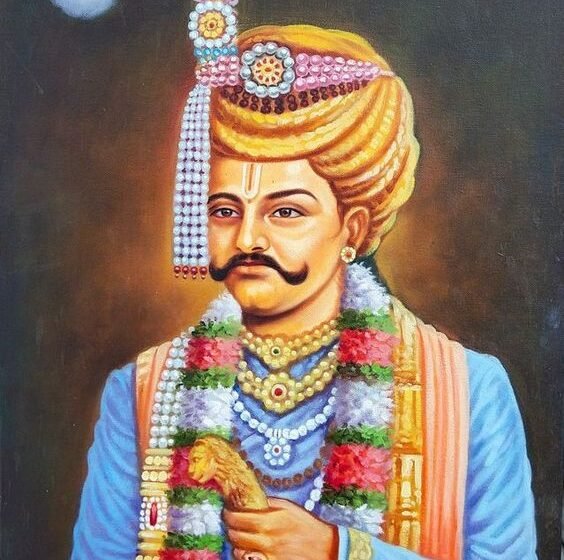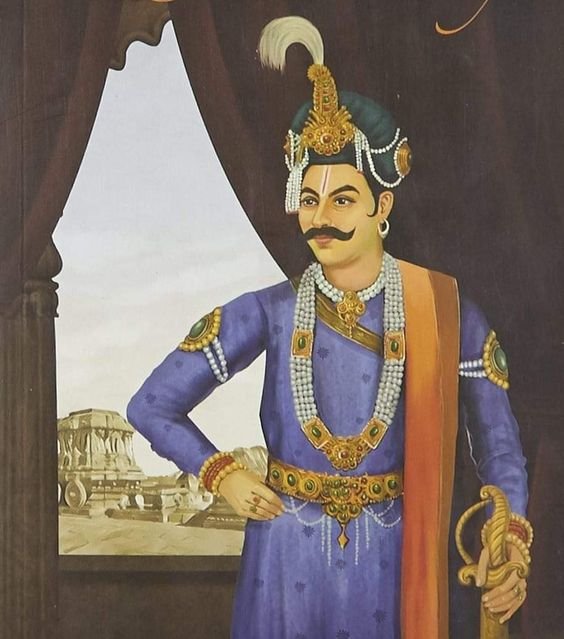Krishnadevaraya : The lord of Jewelled throne of Vijayanagara Empire
- Uncategorized
 Goutham P
Goutham P- April 2, 2023
- 0
- 1220

Krishnadevaraya : The lord of Jewelled throne of Karnataka established the King of Bahmani to the throne.
Vijayanagar Empire was founded by the brothers Harihara and Bukka in 1336 in the southern bank of Tungabhadra River. The city of Victory (Vijayanagar) previously called Hosapattana, was ruled by four dynasties for over 300 years. These were the Sangama, Saluva, Tuluva and Aravidu.
The present day Hampi in Karnataka is the place where once stood the mighty Vijayanagar Empire. Their royal emblem was borrowed from the Chalukyas – Varaha (the boar).

Reigning Vijayanagar for 20 years till 1529 and making it the largest empire in India, Krishna Deva Raya, the third descendant of Tuluva dynasty held together and added more territories through his conquests.
Krishnadevaraya born in 1471 to Narasa Nayaka and Nagamamba was a formidable warrior, an able diplomat and a generous patron of art, architecture and literature. He composed in Telugu, Amuktamalyada – a work on statecraft. He popularised the Amara Nayak System wherein the king allocated lands to Nayaks (military chiefs) who in turn had to maintain army for the service of the king and send revenues collected from the people.

In the memory of his mother, he founded Nagalapuram township. He had a brother Achyuta Deva Raya.
Krishnadevaraya married Tirumala Devi and Chinna Devi; and had Tirumalamba and Tirumala Raya through Tirumala Devi; Vengalamba through Chinna Devi.
The brothers Rama Raya and Tirumala Deva Raya married Tirumala Devi and Vengalamba respectively.
Most Vijayanagara rulers gave themselves the title Raya by adding it as suffix to their names.

Krishnadevaraya court was adorned with poets like Allasani Peddana. Had the famous Tenali Rama as his advisor and Timmarasu as his Prime Minister.
Kingdom
The welfare state was followed by giving importance to cultural aspects, spirituality, trade, crafts, and infrastructure development. Rulers were patrons of temples like the Brihadishwara at Tanjore and Chennakeshava at Belur.
Using coinage was widespread, leading to trade and development of non-agrarian crafts like weaving. However continuous warfare did accentuate poverty and migration to territories outside the kingdom.
Since the kingdom was situated on an arid region, elaborate arrangements were made to store rainwater. A huge tank called Kamalapuram Tank was built for the same to irrigate the field and supply water to the palaces.

Vijayanagar was located so strategically that it was surrounded by hills on all sides. The entire city was also fortified connecting the walls to the hills. This brought the important structures and the entire agricultural belt and forests into the fortification.
Wars
Krishnadevaraya’s early victory was to bring into submission the rebellious Ummattur Chiefs namely the Reddys of Kondavidu and Velamas of Bhuvanagiri.
There was also constant hostility with Bahmani Kings for control over Raichur Doab and sea ports of Goa, Honavar, etc. The Portuguese governor Albuquerque offered to aid the Vijayanagara Empire in its war efforts with the Bahamanis and the monopoly of Vijayanagar over their horse trade. In return, they requested assistance against the Zamorin of Calicut and to build a fort at Bhatkal. Krishna Deva Raya eventually accepted the offer which helped him in controlling his enemies.
The long tussle with the Deccan Sultan was thereafter put to an end by Krishnadevaraya in the 1509 battle. The founder of the 1st Muslim empire of the Deccan, Mahmood Shah was defeated and his governor of Bijapur Yusuf Adil Shah was killed in 1510 following his defeat in the hands of Portuguese. With this the struggle for Raichur doab came to an end, and it was taken into the Vijayanagar Empire.
Despite the hostility, Krishnadevaraya helped in restoring Bahmani Sultan Mahmud following his imprisonment in a civil war. The city of Gulbarga was taken over by the Sultan’s Prime Minister Amir Barid. Hearing the news, Krishnadevaraya invaded Gulbarga and defeated Amir Barid. He released the Sultan from his prison and crowned him as well. Due to this generosity, Krishnadevaraya was given title of “establisher of the Yavana kingdom”.
In the east, Kalinga of Odisha were the competitors. A Kannada inscription of 1513 found in Krishna Temple at Hampi mentions about Krishnadevaraya’s victory over the Gajapati of Odisha. Gajapatis ruled parts of Bengal, Andhra and Odisha. Following a series of attacks which ultimately came against the favour of Gajapati, its ruler Prataparudra Deva offered his daughter to be married off to Krishna Deva Raya. Accepting the offer, he returned back the lands that were captured.
However, Krishnadevaraya was varied of Bahamani Sultans. In 1527, he again invaded Gulbarga. Tasting the victory in his final battle, he annihilated the entire fortress of Gulbarga. This ended the fierce rivalry as well as the Bahamani Sultanate.

Conclusion
In 1529, Krishnadevaraya fell seriously ill and was succeeded by his brother Achyuta Deva Raya who was then succeeded by his son Venkata 1. He too was soon replaced following his death by Sadasiva Raya (the nephew of Achyuta Deva Raya). Although Sadasiva Raya was a minor, he was made the ruler according to Aliya Santana law. And Rama Raya functioned as his regent.
His successors had tough time dealing with rebel nayakas. In 1542 there was a change in the ruling dynasty from Tuluva to the Aravidu, which ruled till the end of the 17th century. During this period, the Deccan Sultanates despite their differences, decided to form an alliance against Vijayanagara. This was essentially caused by Rama Raya due to his policy of pitting one Sultan against another. Hence, they put their indifferences to the side to combine together and decisively defeat Rama Raya.
The combined forces of the Sultans met at Talikota in 1565. In the ensuing battle, known as Rakasa Tangadi (Battle of Talikota), Rama Raya was killed by the armies of Bijapur, Ahmadnagar and Golconda. The city of Vijayanagara was completely ransacked and was totally abandoned in few years.
Tirumaladeva Raya moved to Chandragiri. There he began the rule of Aravidu dynasty and built a new capital at Penukonda. He was able to keep the empire intact for a short time. The kingdom finally fell apart around 1646 as a result of internal strife and through the plot of the sultans of Bijapur and Golconda.


